#Agile vs Devops
Explore tagged Tumblr posts
Text
How Does Agile and DevOps Interrelate?- OpsNexa!
Learn how Agile and DevOps work together to accelerate software delivery, improve collaboration, and foster continuous improvement. How Does Agile and DevOps Interrelate? Understand how Agile’s iterative approach and DevOps’ automation practices complement each other to create faster, more efficient software development cycles.
#Agile and DevOps#Agile DevOps Integration#Agile vs DevOps#DevOps and Agile Practices#Agile DevOps Synergy#DevOps Methodology
0 notes
Text

Software Development Lifecycle
Agile methodology is a set of principles and values for software development that emphasizes iterative and incremental development, collaboration, and flexibility. When applied in the Product Development Life Cycle (PDLC), Agile practices help teams adapt to changing requirements, deliver value quickly, and continuously improve the product.
Vs
DevOps (Development and Operations) in the Product Development Life Cycle (PDLC) refers to the integration of development, operations, and quality assurance (QA) processes to streamline the delivery of software products or services. The PDLC encompasses all stages of software development, from ideation and planning to deployment and maintenance.
1 note
·
View note
Text
Agile vs. DevOps: Key Differences in Software Product Development

Compare Agile and DevOps to find out which methodology aligns better with your software product development goals, ensuring faster releases and continuous improvements.
0 notes
Text
Automated Testing vs. Manual Testing: Which One is Right for Your Project?
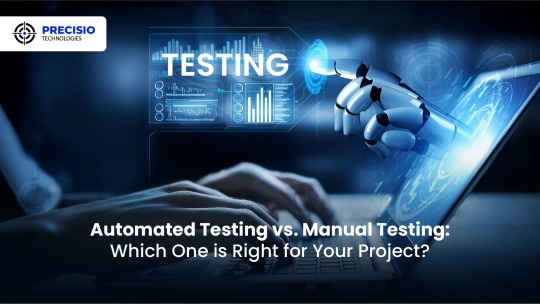
Achieving high-quality, reliable software stands as a fundamental requirement in software development. Successful testing functions as an essential tool to discover faults and build performance capabilities that create better user experience outcomes. Two main testing methods dominate the field: automated testing and manual testing. The process of quality software assurance uses different testing approaches that demonstrate their own advantages as well as weaknesses according to specific project requirements and scenarios. We will explore the specifics to determine which testing process works best for your system development efforts.
1. What Is Manual Testing?
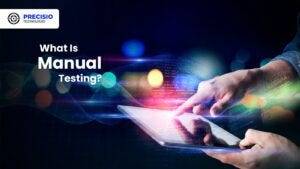
Manual testing involves a human tester manually executing test cases without using automation tools. Key Characteristics:
The methodology focuses its efforts on user interface together with usability and experience testing.
Human-centered applications where selection requires discretion include ad hoc testing and enumerative testing as well as examinations that need human evaluation.
Human performers are required during this approach; thus, it demands substantial time.
2. What Is Automated Testing?
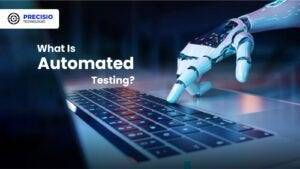
Software performing automated testing executes test cases through workflows and helpers. Key Characteristics:
Efficient for repetitive and regression testing.
Users must spend money on tools along with developing custom scripts for testing.
Reduces human error.
3. Advantages of Manual Testing

Human Intuition: Software testing professionals can detect kernels through their human cognitive ability that automated tools cannot match. The observation and evaluation of visual elements runs more efficiently through human operatives instead of advanced tools.
Flexibility: This method suits exploratory testing specifically because there are no pre-determined scripts available.
Low Initial Investment: Running this approach does not need tool purchases or applications to develop automation frameworks.
Adaptable for UI/UX Testing: Running this approach does not need tool purchases or applications to develop automation frameworks.
4. Advantages of Automated Testing
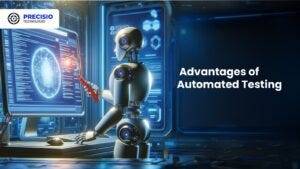
Speed: Executes repetitive tests much faster than humans.
Scalability: The system proves most effective for extensive projects that need constant system updates.
Accuracy: When performing recurring actions, automated systems minimize the chances of human mistakes.
Cost-Efficient in the Long Run: Once established and implemented, the system demands costly investments but ensures continuous development expenses decrease over time.
Better for CI/CD Pipelines: Such testing technology connects various development pipelines that support agile and DevOps methodologies.
5. Disadvantages of Manual Testing

Time-Consuming: The manual performance of repeated tests leads to delayed completion of projects.
Error-Prone: Large applications contain tiny bugs that human testers commonly fail to detect.
Not Ideal for Scalability: The process of increasing manual testing needs additional testers to avoid cost escalations.
6. Disadvantages of Automated Testing
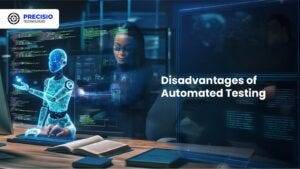
Initial Costs: Organizations must provide high financial resources to procure testing tools together with developing programming constructs.
Limited to Pre-Defined Scenarios: These testing approaches work poorly for handling exploratory or ad hoc testing.
Requires Maintenance: Test scripts need frequent updates when application changes occur.
Not Suitable for UI/UX Testing: Struggles with subjective user experience evaluations.
7. When to Use Manual Testing
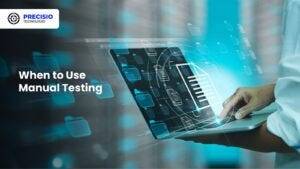
Small Projects: The testing method proves beneficial at a low cost for small applications and provides quick assessments.
Exploratory Testing: Testing this approach benefits projects whose scripts have not been defined yet or need evaluation for newly added features.
Visual and Usability Testing: Performing assessments on interface components together with design features.
8. When to Use Automated Testing
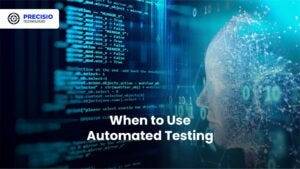
Large Projects: Handles scalability for projects with frequent updates.
Regression Testing: Program testing becomes more efficient through automation since automated assessments perform multiple tests following each update process.
Performance Testing: The system performs efficient capabilities to conduct load testing and stress testing.
Continuous Development Environments: Agile progression and DevOps implementations need automation as a core requirement.
READ MORE- https://www.precisio.tech/automated-testing-vs-manual-testing-which-one-is-right-for-your-project/
2 notes
·
View notes
Text
Full Stack Testing vs. Full Stack Development: What’s the Difference?

In today’s fast-evolving tech world, buzzwords like Full Stack Development and Full Stack Testing have gained immense popularity. Both roles are vital in the software lifecycle, but they serve very different purposes. Whether you’re a beginner exploring your career options or a professional looking to expand your skills, understanding the differences between Full Stack Testing and Full Stack Development is crucial. Let’s dive into what makes these two roles unique!
What Is Full Stack Development?
Full Stack Development refers to the ability to build an entire software application – from the user interface to the backend logic – using a wide range of tools and technologies. A Full Stack Developer is proficient in both front-end (user-facing) and back-end (server-side) development.
Key Responsibilities of a Full Stack Developer:
Front-End Development: Building the user interface using tools like HTML, CSS, JavaScript, React, or Angular.
Back-End Development: Creating server-side logic using languages like Node.js, Python, Java, or PHP.
Database Management: Handling databases such as MySQL, MongoDB, or PostgreSQL.
API Integration: Connecting applications through RESTful or GraphQL APIs.
Version Control: Using tools like Git for collaborative development.
Skills Required for Full Stack Development:
Proficiency in programming languages (JavaScript, Python, Java, etc.)
Knowledge of web frameworks (React, Django, etc.)
Experience with databases and cloud platforms
Understanding of DevOps tools
In short, a Full Stack Developer handles everything from designing the UI to writing server-side code, ensuring the software runs smoothly.
What Is Full Stack Testing?
Full Stack Testing is all about ensuring quality at every stage of the software development lifecycle. A Full Stack Tester is responsible for testing applications across multiple layers – from front-end UI testing to back-end database validation – ensuring a seamless user experience. They blend manual and automation testing skills to detect issues early and prevent software failures.
Key Responsibilities of a Full Stack Tester:
UI Testing: Ensuring the application looks and behaves correctly on the front end.
API Testing: Validating data flow and communication between services.
Database Testing: Verifying data integrity and backend operations.
Performance Testing: Ensuring the application performs well under load using tools like JMeter.
Automation Testing: Automating repetitive tests with tools like Selenium or Cypress.
Security Testing: Identifying vulnerabilities to prevent cyber-attacks.
Skills Required for Full Stack Testing:
Knowledge of testing tools like Selenium, Postman, JMeter, or TOSCA
Proficiency in both manual and automation testing
Understanding of test frameworks like TestNG or Cucumber
Familiarity with Agile and DevOps practices
Basic knowledge of programming for writing test scripts
A Full Stack Tester plays a critical role in identifying bugs early in the development process and ensuring the software functions flawlessly.
Which Career Path Should You Choose?
The choice between Full Stack Development and Full Stack Testing depends on your interests and strengths:
Choose Full Stack Development if you love coding, creating interfaces, and building software solutions from scratch. This role is ideal for those who enjoy developing creative products and working with both front-end and back-end technologies.
Choose Full Stack Testing if you have a keen eye for detail and enjoy problem-solving by finding bugs and ensuring software quality. If you love automation, performance testing, and working with multiple testing tools, Full Stack Testing is the right path.
Why Both Roles Are Essential :
Both Full Stack Developers and Full Stack Testers are integral to software development. While developers focus on creating functional features, testers ensure that everything runs smoothly and meets user expectations. In an Agile or DevOps environment, these roles often overlap, with testers and developers working closely to deliver high-quality software in shorter cycles.
Final Thoughts :
Whether you opt for Full Stack Testing or Full Stack Development, both fields offer exciting opportunities with tremendous growth potential. With software becoming increasingly complex, the demand for skilled developers and testers is higher than ever.
At TestoMeter Pvt. Ltd., we provide comprehensive training in both Full Stack Development and Full Stack Testing to help you build a future-proof career. Whether you want to build software or ensure its quality, we’ve got the perfect course for you.
Ready to take the next step? Explore our Full Stack courses today and start your journey toward a successful IT career!
This blog not only provides a crisp comparison but also encourages potential students to explore both career paths with TestoMeter.
For more Details :
Interested in kick-starting your Software Developer/Software Tester career? Contact us today or Visit our website for course details, success stories, and more!
🌐visit - https://www.testometer.co.in/
2 notes
·
View notes
Video
youtube
Kanban, Waterfall, and DevOps are three different approaches to project management and software development. Here's an overview of each concept: 1. Kanban: Definition: Kanban is a visual management method for software development and knowledge work. It originated from manufacturing processes in Toyota and has been adapted for use in software development to improve efficiency and flow.
Key Concepts: Visualization: Work items are represented on a visual board, usually with columns such as "To Do," "In Progress," and "Done."
Work in Progress (WIP) Limits: Limits are set on the number of items allowed in each column to optimize flow and avoid bottlenecks.
Continuous Delivery: Focus on delivering work continuously without distinct iterations.
Advantages: Flexibility in responding to changing priorities.
Continuous delivery of value. Visual representation of work enhances transparency.
Use Case: Kanban is often suitable for teams with variable and unpredictable workloads, where tasks don't follow a fixed iteration cycle.
2. Waterfall: Definition: The Waterfall model is a traditional and sequential approach to software development. It follows a linear and rigid sequence of phases, with each phase building upon the outputs of the previous one.
Phases: Requirements: Define and document project requirements. Design: Create the system architecture and design. Implementation: Code the system based on the design. Testing: Conduct testing to identify and fix defects. Deployment: Deploy the completed system to users. Maintenance: Provide ongoing support and maintenance.
Advantages:
Clear structure and well-defined phases.
Documentation at each stage.
Predictable timelines and costs.
Disadvantages: Limited flexibility for changes after the project starts.
Late feedback on the final product.
Risk of customer dissatisfaction if initial requirements are misunderstood.
Use Case: Waterfall is suitable for projects with well-defined requirements and stable environments where changes are expected to be minimal.
3. DevOps: Definition: DevOps (Development and Operations) is a set of practices that aim to automate and improve the collaboration between software development and IT operations. The goal is to shorten the development lifecycle, deliver high-quality software, and foster a culture of continuous integration and delivery.
Key Practices: Continuous Integration (CI): Merge code changes frequently and automatically test them.
Continuous Delivery/Deployment (CD): Automate the release and deployment processes.
Collaboration: Promote collaboration and communication between development and operations teams.
Advantages: Faster delivery of software. Reduced manual errors through automation. Improved collaboration and communication.
Use Case: DevOps is suitable for organizations aiming to achieve faster and more reliable delivery of software through the automation of development, testing, and deployment processes.
#mktmarketing4you #distributionchannels #HoshinPlanning #Leanmethods #marketing #M4Y #lovemarketing #IPAM #ipammarketingschool #Kanban #ContingencyPlanning #virtual #volunteering #project #Management #Economy #ConsumptionBehavior #BrandManagement #ProductManagement #Logistics #Lifecycle #Brand #Neuromarketing #McKinseyMatrix #Breakevenanalysis #innovation #Facebook #icebergmodel #EdgarScheinsCultureModel #STARMethod #VRIO #7SFramework #gapanalysis #AIDAModel #SixLeadershipStyles #MintoPyramidPrinciple #StrategyDiamond #InternalRateofReturn #irr #BrandManagement #dripmodel #HoshinPlanning #XMatrix #backtobasics #BalancedScorecard #Product #ProductManagement #Logistics #Branding #freemium #businessmodel #business #4P #3C #BCG #SWOT #TOWS #EisenhowerMatrix #Study #marketingresearch #marketer #marketing manager #Painpoints #Pestel #ValueChain # VRIO #marketingmix We also left a video about Lean vs Agile vs Waterfall | What is Lean | Difference between Waterfall and Agile and that could help you. Later we will leave one about Kanban:
2 notes
·
View notes
Text
How CI/CD Is Changing the Future of Software Development
In today’s fast-paced software world, delivering high-quality features quickly is critical. That's where CI/CD — Continuous Integration and Continuous Delivery/Deployment — comes in. It has revolutionized how teams build, test, and release software. Whether you’re a startup or an enterprise, embracing CI/CD can dramatically improve your development workflow.
Understanding CI/CD
At its core, CI/CD bridges the gap between development and operations. Continuous Integration ensures that every code commit is automatically tested and merged, while Continuous Delivery automates code delivery to staging environments. With Continuous Deployment, the process goes a step further — releasing every change to production automatically.
This automated workflow reduces human error, shortens feedback loops, and enables more frequent, reliable releases.
CI vs CD: What’s the Difference?
The debate around ci versus cd often confuses beginners. Continuous Integration focuses on integrating code frequently, validating each change with automated tests. In contrast, Continuous Delivery and Deployment deal with automating release pipelines — ensuring software is always ready for production or released immediately.
In short:
CI = Frequent code merges + automated testing
CD = Automated release to staging or production
The Rise of CI/CD Technology
With growing software complexity, CI/CD technology is becoming a foundational practice. From cloud-native apps to enterprise-scale microservices, CI/CD pipelines help maintain code quality while supporting rapid iteration.
Modern CI/CD tools like GitHub Actions, GitLab CI, and Jenkins integrate with various cloud providers and testing platforms — making deployment more seamless and robust.
Real-World CI/CD: Google and Beyond
Tech giants like Google have long championed Google Continuous Integration practices, running thousands of builds and deployments daily. Their success with CI/CD showcases how automation, infrastructure as code, and scalable pipelines can enhance delivery speed and software reliability.
Startups and mid-sized teams are following suit, adopting similar principles with tailored CI/CD stacks.
The Role of Software Continuous Integration
Software continuous integration acts as the backbone of modern DevOps culture. It ensures that small, frequent updates are integrated, tested, and ready to deploy at all times. This reduces the chance of large-scale merge conflicts and improves overall software stability.
CI also encourages writing better tests and promotes accountability, making collaboration smoother among developers.
Visualizing the Pipeline: Continuous Integration Images
To help teams and stakeholders understand the CI/CD workflow, continuous integration images and diagrams are widely used. These visuals illustrate how code moves from the developer’s machine through automated tests, builds, staging, and finally into production — often with rollback or approval gates.
Visual tools also help DevOps engineers optimize and troubleshoot pipeline bottlenecks.
Continuous Development and Continuous Integration: The Perfect Match
The synergy of continuous development and continuous integration fuels agile innovation. As developers commit small changes regularly, CI ensures those changes are safe to merge. Coupled with continuous testing, this leads to faster releases, greater reliability, and happier users.
This powerful combination reduces the time between idea and delivery — keeping organizations competitive in the ever-evolving tech landscape.
Final ThoughtsCI/CD isn’t just a buzzword — it’s a paradigm shift. From faster feedback to reduced risk and improved quality, adopting CI/CD is crucial for any team aiming for scalable, efficient software delivery. Whether you're inspired by Google's CI practices or just starting with basic automation, embracing CI/CD is the way forward.
0 notes
Text

In today’s agile-driven development world, automation testing has become more than a luxury—it’s a necessity. Among the various automation tools available, Selenium has maintained its position as an industry standard for over a decade. Open-source, versatile, and language-agnostic, Selenium empowers QA engineers and developers to create robust, scalable, and efficient automated test scripts for web applications. Whether you're a beginner in automation or a seasoned tester, this comprehensive guide will walk you through the most popular Selenium tools, frameworks, and best practices to boost your test efficiency and software quality.
What Is Selenium?
Selenium is an open-source automation testing tool primarily used for web applications. It supports multiple programming languages like Java, Python, C#, JavaScript, and Ruby. The tool allows testers to write functional tests without learning a new scripting language.
Key Components of Selenium:
1. Selenium WebDriver: The core component that allows browser-based automation.
2. Selenium IDE: A record-and-playback tool for quick test script creation.
3. Selenium Grid: Enables parallel test execution across different environments and machines.
4. Selenium RC (deprecated): Previously used for remote browser control, now replaced by WebDriver.
Popular Tools and Frameworks Used with Selenium
To unlock Selenium’s full potential, pairing it with the right tools and frameworks is essential. Here are some of the most popular ones:
1. TestNG / JUnit (Java)
2. Maven / Gradle
3. Cucumber (BDD Framework)
4. Allure / ExtentReports
5. Docker + Selenium Grid
6. Jenkins / GitLab CI/CD
Best Practices for Selenium Testing Success
A robust Selenium testing strategy involves more than just writing scripts. Below are expert-recommended best practices to ensure sustainable and efficient automation: 1. Use the Page Object Model (POM) Structure your code by separating locators and interaction logic. This improves maintainability and readability. 2. Avoid Hard Waits Use Explicit Waits and Fluent Waits instead of Thread.sleep(). This improves script reliability and speed. 3. Run Tests in Headless Mode For faster execution during CI pipelines, especially when GUI isn’t required. 4. Validate Results with Assertions Incorporate assertions (e.g., AssertEquals, AssertTrue) to verify actual vs. expected outcomes. 5. Handle Dynamic Elements Smartly Use robust locator strategies like CSS selectors or XPath with relative paths. Avoid brittle locators. 6. Keep Tests Atomic Each test case should be independent and test one specific functionality. This makes debugging and maintenance easier. 7. Enable Cross-Browser Testing Use tools like BrowserStack or Sauce Labs to verify application behavior across multiple browsers and devices. 8. Version Control and Code Reviews Manage your test suite using Git, and regularly conduct peer reviews to enhance script quality.
Conclusion :
Selenium remains one of the most powerful tools in the QA toolkit, thanks to its flexibility, community support, and integration capabilities. By combining it with the right frameworks and following proven best practices, teams can achieve faster releases, better quality assurance, and increased confidence in software delivery. Ready to level up your automation game? Contact us today and start integrating Selenium with modern DevOps pipelines, and watch your testing efficiency soar.
#software testing training#automation testing training in ahmedabad#selenium training in ahmedabad#manual testing#unicodetechnologies
0 notes
Text
From Concept to Code: A Step-by-Step Guide to Custom E-commerce Development

In today’s digital-first world, launching an e-commerce store is no longer a luxury—it’s a necessity. But if you're aiming to stand out in a sea of templated online shops, custom e-commerce development is the way to go.
Unlike off-the-shelf solutions, a custom-built e-commerce platform is designed around your business goals, customer needs, and brand identity. Here's a comprehensive, step-by-step guide to help you understand how an idea transforms into a fully functional e-commerce solution.
1️⃣ Step 1: Defining the Concept and Business Goals
Every successful project starts with clarity. Ask yourself:
What are you selling—and why?
Who is your target audience?
What’s your unique value proposition?
What are your short- and long-term goals?
At this stage, you should also decide on key business models (B2B, B2C, marketplace, etc.) and revenue strategies (direct sales, subscriptions, freemium, etc.).
2️⃣ Step 2: Requirements Gathering & Planning
This phase involves collaboration between stakeholders, developers, designers, and marketing teams. Key deliverables include:
Functional requirements (product catalog, cart, checkout, etc.)
Technical requirements (CMS, third-party integrations, APIs)
Compliance needs (PCI DSS, GDPR, taxation, etc.)
Budget, timelines, and scalability considerations
Outcome: A detailed project roadmap and a prioritized feature list (MVP vs. future enhancements).
3️⃣ Step 3: UX/UI Design
First impressions matter. Your e-commerce platform needs a seamless, intuitive, and responsive interface. Design involves:
Wireframes for layout structure
High-fidelity mockups for branding and UI elements
User journey mapping (product search, filter, cart, checkout, etc.)
A well-designed UX not only boosts customer satisfaction but also drives conversions.
4️⃣ Step 4: Technology Stack Selection
Choosing the right tech stack is critical for performance, scalability, and ease of maintenance. Common tools and platforms include:
Frontend: React.js, Vue.js, Tailwind CSS
Backend: Node.js, Laravel, Django, Ruby on Rails
Databases: PostgreSQL, MongoDB, MySQL
E-commerce engines: Shopify (Headless), Magento, WooCommerce, or fully custom frameworks
DevOps & Hosting: AWS, Azure, Vercel, Netlify, Docker, CI/CD tools
5️⃣ Step 5: Development Phase
Now the coding begins. This phase is typically divided into sprints (Agile methodology), where each sprint delivers specific features:
User authentication & role management
Product catalog & inventory
Shopping cart & checkout
Payment gateways (Stripe, PayPal, Razorpay, etc.)
Order management & notifications
Admin dashboards
APIs for mobile apps or third-party tools
Ensure secure, well-documented, and scalable code throughout.
6️⃣ Step 6: Quality Assurance & Testing
Before going live, your platform must be tested for:
Functionality (all features working as intended)
Usability (smooth user interactions)
Performance (load time, stress testing)
Security (data encryption, access control, etc.)
Cross-browser and mobile responsiveness
Automated testing tools like Selenium or manual QA play a crucial role here.
7️⃣ Step 7: Deployment & Launch
Once tested and approved, the platform is deployed to a production environment. Key tasks here include:
Domain setup & SSL configuration
Database migration
CDN & caching setup
SEO optimization
Analytics integration (Google Analytics, Facebook Pixel, etc.)
Soft launches or beta testing can help gather early feedback before a full-scale public release.
8️⃣ Step 8: Post-Launch Support & Continuous Improvement
Going live isn’t the finish line—it’s the beginning. Post-launch activities include:
Performance monitoring
Bug fixes and patching
Feature upgrades
Customer feedback loops
A/B testing for UX enhancements
E-commerce success is a marathon, not a sprint.
Final Thoughts
Custom e-commerce development is a journey that requires thoughtful planning, technical expertise, and ongoing collaboration. But the payoff? A platform that truly aligns with your brand and delivers a frictionless shopping experience your customers will love.
If you're considering building your own custom e-commerce solution, partnering with the right development team can make all the difference.
🔍 Looking for a reliable partner to build your next e-commerce platform? Let’s talk! Winklix specializes in tailor-made e-commerce development that drives sales and scales with your business.
#custom software development company in seattle#software development company in seattle#custom software development companies in seattle#top software development company in seattle#best software development company in seattle#custom software development company in new york#software development company in new york#custom software development companies in new york#top software development company in new york#best software development company in new york#custom software development company in chicago#software development company in chicago#custom software development companies in chicago#top software development company in chicago#best software development company in chicago
0 notes
Text
Vue JS Services That Elevate Your Frontend to the Next Level
Introduction As digital products become more complex and user expectations rise, having a sleek, responsive frontend is more crucial than ever. Vue.js is a powerful solution for building modern interfaces. Businesses looking for custom frontend development can benefit greatly from professional vue js services.
What Do Vue JS Services Include?
UI/UX Design and Prototyping
Custom VueJS App Development
Single Page Applications (SPA)
Progressive Web App (PWA) Development
Migration to Vue.js
Vue + Nuxt SSR Development
Third-party API integration
Maintenance and Support
Why Choose Vue for Your Frontend?
Simplicity with Power Vue is easy to learn but powerful enough to handle large-scale apps.
Performance-Oriented Fast rendering, minimal footprint, and quick updates deliver better UX.
Versatile Applications Ideal for everything from landing pages to enterprise dashboards.
Vue Services vs. In-House Development
While building in-house can work for small changes, engaging with Vue JS service providers gives you:
Immediate access to skilled developers
Accelerated timelines
Professional UI/UX support
DevOps and CI/CD setup
Full testing and QA workflows
Pair with Backend Frameworks
Vue works great with Node.js, Firebase, Django, or Laravel — making it suitable for full-stack projects.
Collaborating with the Right Experts
Teams that specialize in vuejs app development bring battle-tested experience in building SPAs, optimizing performance, and integrating with APIs. Their services go beyond code — offering project planning, testing, and deployment.
Final Thoughts If your business needs beautiful, functional, and scalable frontends, investing in professional vue js services will ensure long-term product success. From MVP to enterprise-level apps, Vue offers unmatched agility and performance for all types of projects.
0 notes
Text
Looking for a QA Testing Course With Placement Support?
In today’s competitive tech landscape, simply learning quality assurance (QA) testing isn’t enough. You need a course that not only teaches the fundamentals and advanced techniques but also guides you toward job readiness with placement support. Whether you're switching careers, are a recent graduate, or are already working in IT, a QA Testing course with placement support could be your gateway to a stable, high-paying career.
In this blog, we’ll explore:
Why QA Testing is in high demand
What a good QA course includes
How placement support makes all the difference
Skills you’ll gain from such a program
Career paths after QA certification
Why QA Testing Is One of the Most In-Demand IT Careers
Quality Assurance (QA) plays a crucial role in software development. Before any application hits the market, be it a mobile app, web application, or enterprise system it goes through rigorous QA testing to ensure it functions correctly and meets user expectations.
Industry Growth
According to a report by Global Market Insights, the software testing market is expected to surpass $60 billion by 2030. Companies are pouring more investment into QA to avoid costly bugs and deliver seamless digital experiences. As a result, there's an ongoing demand for trained QA professionals across industries.
Career Stability
QA roles are no longer viewed as entry-level jobs. Today, QA engineers, test analysts, and automation testers command competitive salaries and have clearly defined career paths leading up to roles like QA Lead, Test Architect, and even DevOps or Product Manager.
What Makes a QA Testing Course Stand Out?
Not all QA courses are created equal. If you’re looking for a QA software tester course with placement support, here’s what to look for:
1. Industry-Relevant Curriculum
A top-tier QA course should cover both manual and automation testing. Core topics often include:
Software Development Life Cycle (SDLC)
Testing Life Cycle (STLC)
Test Case Design Techniques
Bug Lifecycle and Reporting
Agile & Scrum methodologies
Tools: JIRA, Selenium, TestNG, Postman, JUnit, LoadRunner, QTP/UFT
Advanced programs may also include exposure to CI/CD pipelines, Jenkins, Git, and cloud-based testing platforms.
2. Hands-On Projects
Theory is essential, but hands-on training is where you truly build confidence. The best QA courses include real-world projects such as:
Testing a live web application
Writing test scripts using Selenium
API testing with Postman
Creating bug reports and managing sprints in JIRA
These projects help simulate workplace scenarios and make your resume more attractive to employers.
3. Placement Support Services
A high-quality QA Testing course with placement support will offer:
Resume building and LinkedIn optimization
Mock interviews and HR interview preparation
Real job referrals and recruiter connections
Interview feedback and personalized guidance
This end-to-end placement support bridges the gap between learning and employment, an essential aspect for career success.
Key Skills You’ll Gain from a QA Testing Course with Placement
Enrolling in a QA Testing course with placement support can transform your skill set and job prospects. Here's a breakdown of the top skills you'll gain:
1. Manual Testing Fundamentals
You'll learn how to:
Write test cases and test scenarios
Identify and document bugs
Understand functional, regression, smoke, and sanity testing
Perform black-box and white-box testing
2. Automation Testing
Automation testing saves time and increases accuracy. You’ll gain experience with:
Writing Selenium WebDriver scripts in Java or Python
Using testing frameworks like TestNG and JUnit
Understanding XPath and locators
Implementing Page Object Model (POM)
3. API Testing and Postman
As APIs power modern applications, understanding how to test them is vital. You’ll learn:
REST vs. SOAP APIs
Using Postman for API testing
Writing automated API tests using JavaScript
4. Agile and Scrum Methodology
Modern QA teams work in Agile environments. You’ll understand:
Sprint planning and daily standups
Scrum roles and ceremonies
User stories and acceptance criteria
5. Defect Tracking and Reporting
Using tools like JIRA or Bugzilla, you’ll gain hands-on knowledge of:
Logging and tracking bugs
Creating dashboards and filters
Assigning severity and priority
Why Placement Support Makes All the Difference
Imagine completing a course only to struggle endlessly to land interviews. That’s where placement support becomes a game-changer.
1. Resume and LinkedIn Optimization
Your resume is your first impression. Courses with placement support offer:
Custom resume templates tailored for QA roles
Keyword-rich formatting to pass Applicant Tracking Systems (ATS)
LinkedIn profile enhancements for recruiter visibility
2. Mock Interviews
Mock interviews simulate real technical and HR interviews, helping you:
Understand what interviewers are looking for
Get rid of nervousness
Receive personalized feedback for improvement
3. Real Job Referrals
Instead of just applying online and waiting endlessly, you'll get:
Referrals to open positions
Access to job fairs and exclusive recruiter connections
Help navigating offer letters and salary negotiation
Who Should Enroll in a QA Testing Course with Placement?
This course is ideal for:
Freshers looking for their first IT job
Non-IT professionals switching to a tech career
Manual testers upskilling to automation testing
College graduates seeking job placement
Stay-at-home moms or career gap candidates looking to re-enter the job market
Career Opportunities After QA Testing Certification
Once you complete your QA Testing course with placement, you’re eligible for several high-paying and stable roles, including:
1. Manual QA Tester
Average Salary: $60,000 - $75,000/year
2. Automation Test Engineer
Average Salary: $80,000 - $110,000/year
3. QA Analyst or QA Engineer
Average Salary: $70,000 - $90,000/year
4. Performance Tester or Load Tester
Average Salary: $85,000 - $105,000/year
5. Test Lead or QA Manager
Average Salary: $100,000 - $130,000/year
And with experience, you can evolve into:
SDET (Software Development Engineer in Test)
DevOps QA Engineer
Product Owner or Scrum Master
Real Success Story: From Waitressing to QA Engineering
Take the story of Priya R., who was working in hospitality when she enrolled in a QA Testing course with placement support. Within six months, she landed her first QA Analyst role with a tech startup. Today, she's an Automation Engineer earning over $95,000/year.
The right course + mentorship + job support = Career breakthrough.
How to Choose the Right QA Testing Course
With so many options, it’s easy to get overwhelmed. Here’s a checklist:
Does the course cover both manual and automation testing?
Are tools like Selenium, JIRA, and Postman included?
Is there hands-on project work included?
Do they offer 1-on-1 mentorship?
Are mock interviews and job referrals part of the package?
Can you access live sessions or recordings for flexibility?
If the answer is "yes" to all, you're on the right path.
Conclusion:
If you’re seriously looking for a Quality assurance courses online with placement support, now is the perfect time to act. The demand for skilled QA testers continues to rise. With the right training, real-world projects, and job placement assistance, you can go from zero experience to landing a role in tech in under 6 months.
Instead of learning in isolation, choose a course that supports your full journey from learning to earning.
Key Takeaways
QA testing is a high-demand career with excellent growth prospects.
A strong QA course covers manual and automation tools like Selenium and Postman.
Placement support is vital—mock interviews, resume building, and referrals give you a competitive edge.
The right QA course can help anyone from freshers to career changers break into tech.
Ready to kickstart your QA career with placement support? Find a training program that fits your goals and take the first step toward a successful future in tech.
0 notes
Text
Is DevOps and Agile the Same?- OpsNexa!
Explore the key differences and similarities between DevOps and Agile. Is DevOps and Agile the Same? While they are complementary, this guide will help you understand how each methodology addresses different aspects of the software development lifecycle and how they work together to accelerate development and deployment.
#DevOps vs Agile#Agile Methodology#Agile vs DevOps Differences#DevOps and Agile Comparison#Agile Development#DevOps Culture
0 notes
Text
Hire JavaScript Developer: Why It’s the Smart Move for Your Next Project
If you're building a modern website, web app, or even a full-scale SaaS platform, there's one programming language you can’t ignore JavaScript.
Whether it's frontend frameworks like React and Vue or backend with Node.js, JavaScript dominates the full-stack development scene. But to make the most of this powerful language, you need the right talent. In other words, you need to hire a JavaScript developer who knows their way around clean code, performance optimization, and scalable architecture.
In this blog, we’ll break down what JavaScript developers do, where they fit in your project, what skills to look for, and how to hire the right one (freelance or full-time).
Why JavaScript?
Let’s start with the obvious question why JavaScript?
Because it’s everywhere.
Frontend: JavaScript powers interactivity on the web using libraries like React, Angular, and Vue.
Backend: Thanks to Node.js, developers can build server-side apps using JavaScript.
Mobile: Frameworks like React Native allow building cross-platform mobile apps.
Real-time Apps: Perfect for chat apps, games, and collaboration tools.
SaaS & Web Apps: Almost every modern SaaS platform has JavaScript at its core.
In short, JavaScript is full-stack friendly, fast, scalable, and supported by a massive ecosystem.
Who is a JavaScript Developer?
A JavaScript developer is someone who specializes in writing, testing, and debugging JavaScript code that powers web interfaces, APIs, or even native mobile apps.
There are three common roles:
Frontend JavaScript Developer – Focuses on UI/UX, responsive layouts, and interactivity.
Backend JavaScript Developer – Builds server-side logic, APIs, databases using Node.js or frameworks like Express.js.
Full-Stack JavaScript Developer – Handles both frontend and backend using a unified JS-based stack (think MERN: MongoDB, Express, React, Node).
Key Skills to Look for When You Hire a JavaScript Developer
Not all JavaScript developers are created equal. Here’s a checklist of must-have skills, depending on your project:
Core JavaScript (ES6+)
Understanding of variables, arrays, loops, classes, promises, async/await, etc.
Frontend Frameworks
Experience in one or more: React.js, Angular, Vue.js, Svelte.
Backend with Node.js
Knowledge of Express, REST APIs, real-time communication (WebSockets), etc.
Version Control
Git/GitHub proficiency for code collaboration.
Testing Tools
Jest, Mocha, Cypress for unit and integration testing.
Database Integration
Working knowledge of MongoDB, MySQL, PostgreSQL.
Deployment & DevOps (Bonus)
CI/CD, Docker, cloud platforms like AWS or Vercel.
Communication & Teamwork
Clean coding is important, but so is the ability to explain, collaborate, and document.
When Should You Hire a JavaScript Developer?
You should consider hiring a JavaScript developer if you are:
Building a custom website or web app
Creating a SaaS or PWA
Developing a single-page app (SPA)
Planning a real-time chat or collaborative tool
Migrating from legacy tech to modern JS stack
Wanting to scale your product fast with clean, maintainable code
Whether it's a new startup idea or expanding an enterprise solution, JavaScript developers bring agility and performance to the table.
Freelance vs In-House vs Remote JavaScript Developer
Here’s a quick comparison to help you decide which hiring model suits you best: Model Pros Cons Freelancer Cost-effective, short-term, flexible Less control, variable quality In-house Aligned with company vision, full-time Higher cost, longer onboarding Remote Dedicated Developer Balance of quality and cost, flexible hours Needs project management setup
If you're a startup or mid-size business, hiring a remote or dedicated JavaScript developer from a trusted service provider gives you the best of both worlds.
Interview Questions to Ask a JavaScript Developer
Here are a few practical questions to evaluate their skill:
Explain the difference between == and === in JavaScript.
What’s event bubbling and how do you stop it?
How does async/await work under the hood?
What is a closure? Can you give a real-world use case?
How would you handle error logging in a Node.js app?
Have you worked with RESTful APIs or GraphQL?
These help you assess both foundational knowledge and practical experience.
Where to Hire JavaScript Developers
You have several options depending on your budget and project urgency:
Freelance Platforms: Upwork, Freelancer, Toptal
Job Boards: LinkedIn, Indeed, Stack Overflow Jobs
Tech Communities: GitHub, Reddit, Dev.to
Software Development Companies: (like us at HashStudioz 👋)
If you’re looking for pre-vetted developers with proven project experience, hiring through an established development partner is a faster, safer route.
Why Hire from HashStudioz Technologies?
At HashStudioz Technologies, we offer flexible engagement models to help you hire dedicated JavaScript developers who are:
✔️ Experienced in modern JS frameworks (React, Node, Vue, etc.)
✔️ Aligned with your time zone and communication style
✔️ Equipped with Agile development practices
✔️ Available for full-time, part-time, or project-based roles
Whether you're a startup, SME, or enterprise, we provide scalable developer support that fits your workflow and budget.
Final Thoughts
Hiring a JavaScript developer is one of the smartest investments you can make for your tech project. From interactive frontends to scalable backends, they bring versatility, speed, and functionality to your digital product.
But hiring the right talent is just as important as choosing the right technology. So be clear about your project goals, evaluate skills thoughtfully, and partner with a trusted provider.
#javascript development#javascript#coding#javascript developer#javascript development firm#hire javascript developer
0 notes
Text
Revolutionizing QA: How AI is Redefining Software Testing Services

In an era of hyper-accelerated digital transformation, quality is no longer a luxury—it’s a non-negotiable. Modern users expect intuitive, seamless, and bug-free experiences across all devices, platforms, and interactions. For organizations striving to meet these demands, conventional testing methods often fall short. That’s why Artificial Intelligence (AI) is quickly becoming the foundation of next-generation QA Testing Services.
AI is transforming the landscape of Software Testing Services from reactive quality control into intelligent, proactive quality engineering. At Robotico Digital, we’ve witnessed firsthand how AI-powered QA can redefine velocity, precision, and coverage in the software lifecycle.
This blog dives into the core ways AI is reshaping QA—from intelligent automation to predictive analytics—highlighting why this transition is not just beneficial but necessary for businesses aiming to stay competitive in the software-driven economy.
Understanding the Shift: Traditional QA vs. AI-Powered QA
Traditionally, QA relied on either manual processes or scripted automation, both of which demanded significant effort in test planning, script writing, execution, and maintenance. While automation tools brought improvements in speed and repeatability, they still required continuous human oversight.
AI changes this paradigm fundamentally. By incorporating machine learning, natural language processing, and pattern recognition, AI can:
l Detect previously unseen bugs
l Adapt to UI and backend changes automatically
l Learn from historical test data
l Recommend smarter test coverage
l Continuously improve test accuracy and efficiency
This evolution from static to intelligent QA aligns perfectly with agile, DevOps, and continuous delivery methodologies that demand speed without compromising quality.
Key Innovations AI Brings to QA Testing Services
AI introduces several advanced capabilities into the QA lifecycle that were previously impossible or too complex to execute manually. Let’s explore the most impactful innovations:
1. Intelligent Test Case Generation
One of the most significant bottlenecks in QA Testing Services is the time spent manually creating and updating test cases. AI algorithms trained on user stories, application logs, and historical defect data can automatically generate relevant and high-impact test cases.
These algorithms understand functional specifications and create test paths that reflect real user behavior, increasing the likelihood of identifying critical bugs early in the cycle. This not only improves test relevance but drastically reduces test creation time.
2. Test Suite Optimization and Prioritization
Running thousands of tests for every minor build change is neither practical nor efficient. AI introduces risk-based testing strategies that prioritize test cases based on factors such as:
l Frequency of code changes
l Defect history
l Module complexity
l User behavior analytics
With AI-based prioritization, Robotico Digital enables clients to focus QA efforts where they matter most—improving test coverage while reducing execution time and costs.
3. Self-Healing Test Automation
One of the most groundbreaking innovations in Software Testing Services using AI is self-healing test automation. In traditional automation frameworks, even small UI changes—like the renaming of a field or relocation of a button—can break test scripts.
AI mitigates this by using intelligent element recognition. Through visual recognition and pattern matching, AI can identify and interact with UI components even if their properties change. This results in tests that are more resilient and require minimal maintenance, freeing up QA teams to focus on more strategic tasks.
4. Predictive Defect Detection
Predictive analytics is a major strength of AI in QA. By analyzing past defects, development activity, and code complexity, AI models can forecast which areas of the application are most likely to contain bugs.
This enables teams to test more strategically—concentrating efforts on the riskiest modules early in the development cycle. Robotico Digital implements predictive QA layers that detect fault-prone areas and offer recommendations for early intervention.
5. Autonomous Regression Testing
Regression testing ensures that new changes don’t break existing functionality, but it’s resource-intensive. AI revolutionizes regression testing by automating the selection and execution of only the most relevant tests.
AI continuously monitors code changes and system behavior to determine which parts of the application are impacted. It then executes only the necessary tests while skipping irrelevant ones—achieving faster feedback loops and more efficient CI/CD pipelines.
6. Test Data Generation and Management
Effective testing requires relevant and diverse data sets. Manually creating such data is time-consuming and error-prone. AI can generate synthetic test data that mimics production data while maintaining compliance with privacy regulations.
AI algorithms can also mask sensitive data automatically and ensure variety in datasets—supporting corner cases and improving test completeness. Robotico Digital leverages AI to automate test data provisioning, making it scalable, secure, and highly customizable.
7. Continuous Testing in DevOps Pipelines
AI brings the much-needed intelligence to continuous testing. It enables QA Testing Services to evolve from scheduled testing to intelligent, event-driven testing that reacts to development activity in real time.
With AI-integrated QA platforms, testing becomes an embedded, always-on process that learns and adapts with every build. At Robotico Digital, we have aligned our testing pipelines with DevOps workflows, where AI not only triggers the right tests but also analyzes and reports results dynamically.
Strategic Benefits of AI-Powered QA Testing Services
Integrating AI into QA provides a host of strategic advantages, which go far beyond simple cost reduction. These include:
Increased Test Coverage
AI enables high-volume test case generation across multiple platforms, devices, and browsers—delivering comprehensive test coverage in record time.
Enhanced Accuracy
By eliminating manual errors and learning from historical bugs, AI significantly improves defect detection accuracy and reduces false positives.
Accelerated Time to Market
Faster test creation, execution, and maintenance mean reduced QA cycles, enabling organizations to release features and updates quicker.
Cost Efficiency
AI reduces redundant testing efforts, streamlines data management, and lowers script maintenance costs—delivering long-term ROI.
Agile and DevOps Alignment
Continuous testing with AI fits seamlessly into agile and DevOps environments, enabling shift-left and shift-right testing with greater precision.
Common Challenges in AI-Based QA and How to Overcome Them
While the promise of AI in QA is massive, implementation does come with certain hurdles:
l Data Quality: Poor or insufficient historical data can reduce AI’s learning capability.
l Tool Complexity: Not all organizations have the infrastructure or integration capacity to adopt AI-based tools.
l Skill Gap: QA professionals may need to reskill to work with AI-enhanced systems.
l Change Management: Organizations may resist replacing legacy systems or altering established QA workflows.
At Robotico Digital, we overcome these challenges with a structured onboarding strategy. Our AI QA platforms are designed to be modular, low-code, and integration-ready. We also offer training programs and ongoing support to ensure smooth transitions and successful adoption.
The Future of QA Testing Services: Intelligent, Autonomous, Continuous
AI is not just improving current QA practices—it’s creating new ones. As the technology matures, we’ll witness the emergence of autonomous QA systems that make intelligent decisions, monitor application health continuously, and even perform self-remediation.
Imagine:
l AI bots identifying defects in production and suggesting fixes
l QA dashboards powered by AI confidence scores
l Voice-enabled QA assistants offering live insights into testing performance
l Testing environments that scale automatically based on application load and code changes
This is not a futuristic vision—it’s a near-term reality that Robotico Digital is actively engineering into its service roadmap.
Conclusion: AI is Reshaping the DNA of Software Testing Services
The integration of Artificial Intelligence into QA Testing Services represents more than a technological advancement—it marks a complete shift in mindset. Quality is no longer an afterthought; it’s an embedded, intelligent, and predictive force within the software development lifecycle.
At Robotico Digital, we believe QA should evolve alongside your product—becoming smarter, faster, and more adaptive with every release. Our AI-powered Software Testing Services are built to support this philosophy, delivering unmatched efficiency, insight, and resilience.
0 notes
Text
Regression Testing: Safeguarding Software Stability After Every Update
As software evolves, new features are added, bugs are fixed, and performance is improved. But every change brings a risk: what if something that used to work now breaks? That’s where regression testing becomes essential.
In this comprehensive guide, we’ll explore what regression testing is, its types, why it matters in today’s CI/CD workflows, how to automate it, and best practices for implementing it across modern development pipelines.
What is Regression Testing?
Regression testing is a software testing process that ensures that recent changes such as code updates, enhancements, or bug fixes haven't broken existing functionalities.
It involves re-running previously executed test cases to confirm that the application still behaves as expected after modifications.
Why Regression Testing Is Crucial
Without regression testing, teams risk introducing unintended bugs into production. These bugs could:
Break mission-critical features
Impact user experience
Cause data loss or security vulnerabilities
Undermine customer trust
By consistently performing regression testing, development teams can release faster and with confidence, knowing that existing functionalities remain intact.
Types of Regression Testing
Type
Description
Corrective
Tests existing test cases without modifying them
Retest-all
Re-runs the entire test suite regardless of where changes occurred
Selective
Runs a subset of test cases relevant to the modified modules
Progressive
Tests new test cases when the software is updated with new features
Partial Regression
Focuses on impacted modules only
Complete Regression
Tests the entire application, typically before a major release
When Should You Perform Regression Testing?
You should perform regression testing:
After every new feature is added
When bug fixes are made
During performance or UI updates
After integration with third-party services
Before major releases
When migrating to a new environment or system
In Agile and DevOps, regression testing is often integrated into every sprint or triggered automatically in CI pipelines.
Manual vs Automated Regression Testing
Manual Testing:
Useful for exploratory and UI testing
Time-consuming for large applications
Prone to human error
Automated Testing:
Fast, reliable, and repeatable
Scales with product complexity
Ideal for running test suites regularly in CI/CD workflows
👉 Best practice: Automate what’s repeatable; test manually what’s unpredictable.
Tools for Regression Testing
Here are some widely-used tools for building and executing automated regression test suites:
Selenium – Open-source framework for web UI automation
Cypress – Developer-friendly tool for end-to-end browser testing
JUnit/TestNG – Unit testing frameworks for Java
Keploy – Auto-generates test cases from real API traffic with mocks
Playwright – End-to-end testing across Chromium, Firefox, and WebKit
Postman/Newman – Great for regression testing APIs
How Keploy Enhances Regression Testing
Traditional regression testing requires manual script writing and maintenance. But tools like Keploy revolutionize the approach by:
Capturing real API traffic
Automatically generating test cases and mocks
Replaying tests in local or CI environments
Ensuring consistent results across dev, staging, and prod
Keploy’s test generation capabilities help maintain high test coverage with minimal effort, especially for integration and API-level testing.
Integrating Regression Testing in CI/CD
In fast-moving development teams, regression testing is not optional—it must be continuous and automated.
Here’s how to integrate it in your CI/CD pipeline:
Trigger tests on every pull request or after merging
Use GitHub Actions, Jenkins, or GitLab CI to automate test runs
Fail the build if critical tests fail
Record and monitor flaky tests
Use dashboards to track test coverage and stability
Best Practices for Regression Testing
✅ Maintain a reliable suite of automated test cases
✅ Prioritize high-risk, high-impact features
✅ Tag and organize tests for easier selection (e.g., smoke, sanity, critical path)
✅ Regularly update and refactor test scripts
✅ Use mocks and stubs to isolate dependencies
✅ Track flaky tests and avoid false positives
✅ Run fast smoke regression tests on every commit
✅ Do full regression cycles before major releases
Common Challenges and How to Overcome Them
Challenge
Solution
Test suite grows too large
Use test prioritization and selective testing
Flaky tests
Stabilize environments, isolate dependencies
Maintenance overhead
Use tools like Keploy to auto-generate tests
Long execution times
Parallelize tests and use CI caching
Regression Testing Use Case Example
Imagine you’re building an e-commerce platform. You fix a bug in the checkout logic. Without regression testing, this could break:
Discount application logic
Cart item validation
Payment gateway integration
With automated regression testing in place, all of the above would be verified before pushing to production, reducing risk and downtime.
Final Thoughts
Regression testing is the backbone of stable software development. As codebases grow and features are added rapidly, having a reliable regression test suite ensures that progress doesn’t come at the cost of reliability.
Whether you're building web apps, mobile apps, or APIs, regression testing gives teams the confidence to innovate without fear of breaking what already works.
0 notes
Text
What Tools Do Full Stack Developers Use?
Introduction
In today’s fast-paced tech world, full-stack developers are the Swiss army knives of web development. They handle both front-end and back-end tasks, building complete web applications from start to finish. But to do that efficiently, they rely heavily on a suite of developer tools designed to make their lives easier.
Why Full-Stack Developer Tools Matter
Whether it's writing code, debugging, or deploying applications, the right tools can dramatically improve productivity and code quality. Full-stack developer tools help automate repetitive tasks, simplify collaboration, and streamline the entire development workflow.
Top Tools Every Full-Stack Developer Should Know
1. CodePen
CodePen is an online editor for testing and showcasing HTML, CSS, and JavaScript. It’s great for prototyping, collaboration, and getting quick visual feedback. Whether you're a beginner or a pro, it helps you experiment and learn quickly.
2. Django
Django is a powerful Python web framework known for its speed, scalability, and built-in security features. It includes an admin panel, supports authentication, and encourages clean, maintainable code.
3. Visual Studio Code
VS Code is a free, lightweight, yet powerful code editor that supports debugging, version control, and a wide range of extensions. It’s a favorite for its speed, flexibility, and customizability.
4. TypeScript
TypeScript builds on JavaScript by adding static typing, helping developers catch errors before runtime. It’s perfect for managing larger codebases and improving code reliability.
5. WebStorm
WebStorm is a dedicated IDE for JavaScript and TypeScript, offering features like real-time error detection, code completion, and seamless Git integration. It’s ideal for teams working on large-scale JS projects.
6. GitHub
GitHub is a cloud-based version control platform that facilitates collaboration. With features like pull requests, code reviews, and issue tracking, it’s essential for modern development teams.
7. Docker
Docker lets developers package their applications and dependencies into containers, making them portable and consistent across different environments. It’s a key tool in DevOps and cloud-native development.
8. Flask
Flask is a lightweight Python framework that's perfect for small to medium-sized applications and APIs. It’s easy to learn, flexible, and comes with tools for templating and HTTP handling.
9. Electron
Electron allows developers to build cross-platform desktop apps using web technologies like HTML, CSS, and JS. It's widely used for apps like Slack and Visual Studio Code itself.
How These Tools Fit into Development Workflows
These tools integrate seamlessly with Agile, DevOps, and other modern development practices. For example, tools like Jira and Jenkins work well with GitHub and Docker to enable continuous integration and deployment.
Choosing the Right Tools for Your Team
Consider your team’s skills, project complexity, budget, and scalability needs. Look for tools that are easy to use, have strong community support, and fit well with your existing stack.
Final Thoughts
The best full-stack developer tools are the ones that empower your team to build high-quality applications efficiently. Focus on tools that encourage collaboration, support growth, and align with your workflow—and you'll set your projects up for success.
For More Information:- https://www.gsdcouncil.org/blogs/what-tools-do-full-stack-developers-use
0 notes